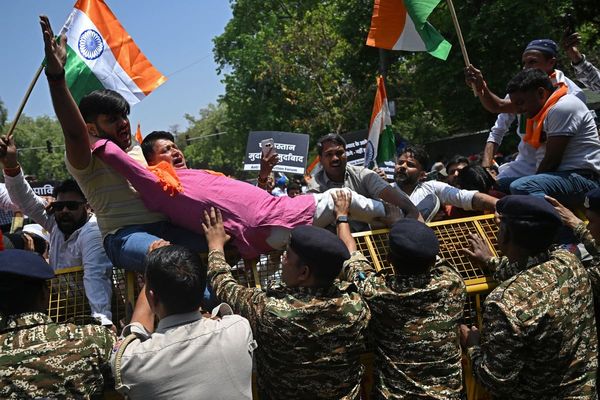
Preferences play a crucial role in deciding Australian elections. In 2022, the winning candidate polled a majority of first preference votes in just 15 out of 151 seats. In 16 seats, the eventual winner did not poll the most first-preference votes.
Parties and candidates issue how-to-vote cards to ensure voters cast a formal vote and to influence how they direct their preferences. That doesn’t mean voters always follow those recommendations, but in some close seats the order in which candidates are listed on how-to-votes can play a key role.
Here are five electorates where preference flows will be closely watched at the 2025 election.
Dickson (Queensland)
The seat held by Peter Dutton on a 1.7% margin covers suburbs on the northern outskirts of Brisbane. There was no expectation at the start of the campaign that it could change hands, but the decline in the Coalition vote in the polls means we are now considering the possibility that Labor could gain seats, with the opposition leader’s very marginal seat possibly in play.
The teal independent candidate, Ellie Smith, is running a prominent campaign, but polls suggest Labor’s Ali France is more likely to emerge as Dutton’s main opponent in the final round of counting. Smith is recommending an open ticket, meaning she does not specify how voters should order the other candidates after giving her their first preference. This is common among the teal independents, and does not affect the outcome when they make it to the final round of counting. But where they fall short, their preferences could be crucial.
In a close race, the flow of preferences from teal voters could decide who wins Dickson. I expect many of Smith’s preferences would flow to Labor, but perhaps fewer than if she had put France above Dutton on her how-to-vote card.
Fremantle (Western Australia)
Kate Hulett, running in the Labor-held seat as an independent, came close to winning the state seat of the same name in March. One thing that brought her undone was the Liberal party’s decision to preference Labor above her.
But now the Liberals have gone the other way for the federal election, directing preferences towards Hulett and the Greens are also preferencing her. This may be enough for Hulett to pose a serious threat to Labor’s Josh Wilson.
Macnamara (Victoria)
This seat in the inner south of Melbourne is particularly complex. In 2022, the Labor, Liberal and Greens candidates polled almost exactly the same first-preference vote. The Greens came third in the key round of counting, enabling Labor to win the seat with a 12.2% margin over the Liberals thanks to Greens preferences.
The seat has one of the largest proportions of Jewish voters in Australia, and there has been a strong push to distance Labor from the Greens over its position on the war in Gaza. Labor has traditionally preferenced the Greens over the Liberals, which would probably lead to a Greens victory if Labor was to fall into third place.
This time the incumbent Labor MP, Josh Burns, has instead issued an open ticket on his how-to-vote card, not recommending preferences. This won’t matter if Burns remains in the top two, in which case he will win, with Liberal preferences helping him beat the Greens, or Greens preferences helping him beat the Liberal. But if Burns falls into third, it is unclear how his preferences will flow. Will Labor preferences still flow strongly to the Greens, or will many Labor voters instead prefer the Liberal candidate?
Leichhardt (Queensland)
Leichhardt covers Cairns and the Cape York peninsula in the far north of Queensland. The Liberal MP, Warren Entsch, is retiring after holding the seat for decades and Labor believes it has a strong chance of winning.
There has been an increasing vote for rightwing minor parties in recent years, and those parties will sometimes try to make their presence known with their preferences.
This year, One Nation is preferencing the Coalition over Labor across the country, in most seats giving the Coalition its second preference. By contrast, Clive Palmer’s Trumpet of Patriots has chosen to put the incumbent major party last, which means it has ranked Labor ahead of the LNP in Leichhardt. Traditionally, Labor has gained strong preference flows from the Greens, while preferences from One Nation and other right-wing minor parties have only slightly favoured the Coalition.
The main challenge for these parties will be to get their how-to-vote cards to potential voters. It’s a big job for the smaller parties to send volunteers to every polling place – including some in very remote areas. A how-to-vote card is no good if voters don’t see it.
Sturt (South Australia)
This inner-city Adelaide electorate is held by the Liberal James Stevens, but is a top target for Labor and a teal independent and has even been mentioned as a Greens target.
Greens voters strongly favour Labor over the Coalition when marking their preferences, but there is more uncertainty when it comes to choosing between Labor and independents.
In some seats the Greens have preferenced the local independent higher, but in Sturt they have preferred Labor over the teal independent Verity Cooper, despite Cooper being a former Greens member.
If the progressive vote is split between Labor and the independent, Greens preferences could be crucial in deciding which candidate makes it to the final count against Stevens.







